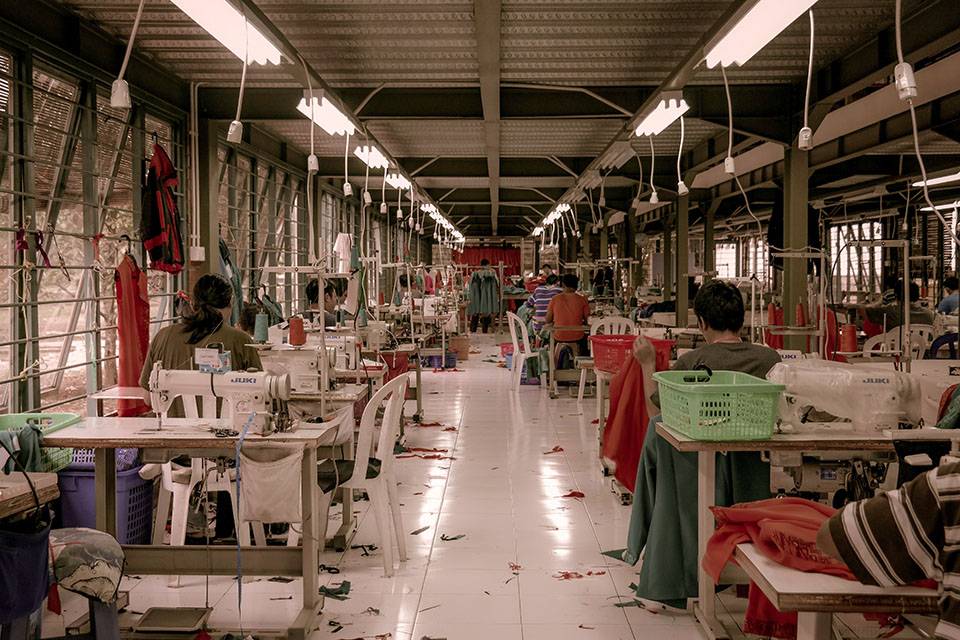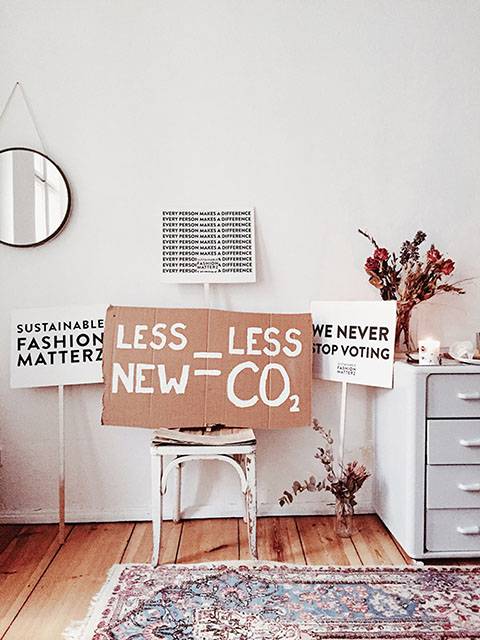Did you know Fashion is the most polluting industry in the world second only to the Oil industry?
Did you know a typical pair of blue jeans consumes 3478 liters of water during its life cycle?
Did you know it takes 2720 liters of water to make a tee-shirt? That is how much normally we drink over a period of 3 years.
But about 50% of clothes are rarely or never worn.
The textile production and demands of fast fashion mean that there are severe impacts on natural resources, exploitation of workers, and environmental damage through manufacturing, waste, and disposal of clothes.
Globalization and the changes in the clothing consumption patterns resulted in apparel overconsumption and the subsequent environmental impacts.
The geographical shift in manufacturing and expansion in trade has profoundly affected the apparel industry. For example, in 1995 the quotas restricting world trade in textiles imports began to be officially removed. Therefore, the liberalization of trade allowed for clothing manufacturers to relocate to developing countries. This business strategy not only became feasible but profitable following the reduction in transport costs, low labour wages, and tax reductions. This has arguably had a great significance, as high-street chains can produce inexpensive clothes which is crucial in the fast fashions’ ideology. However, increasingly affordable and easily available clothes may lead to consumption without deep consideration and used only a few times before being disposed of, creating an unsustainable and wasteful attitude.
The ideology of fast fashion is pressurizing the Earth’s capability to subsist greenhouse gases, harmful chemicals, and manage diminishing water and land resources. There is a high environmental cost for fast fashion as, overall, it contributes to an unsustainable and unobtainable approach.

Many retail chains place pressure on the manufacturing country to further reduce both costs and lead times to remain competitive. Studies on global trade typically discover that international trade has shifted pollution into developing countries, especially within manufacturing industries as their fuel intake increases. This can lead to environmental damage, particularly within carbon rates, energy, and water-intensive practices. The textile industry is considered one of the most polluting in the world due to its energy-intensive methods which release co2 into the atmosphere. The purchase and use of clothing contribute about 3% of global production of co2 emissions.
Additionally, fast fashion expansion would not be possible without the rising use of polyester, which is relatively inexpensive. Demand for man-made fibres, particularly polyester.
Despite polyester lowering costs to create affordable clothes, this fibre is made from petroleum. The manufacturing of polyester and other synthetic fabrics is an energy-intensive process requiring large amounts of crude oil and discharging of co2 emissions.

Unlike polyester, cotton is a natural fibre from a renewable source which is intrinsically biodegradable, however, this can often be misleading as many consumers believe it is environmentally responsible, unfortunately, that is not always the case. Cotton is heavily dependent on pesticides and fungicides. It is estimated that cotton uses only 3% of the world’s farmland, but about 25% of the world’s pesticides. The use of pesticides kills weeds, insecticides, fungus, to allow high quality and amount to be grown, which is necessary for fast fashion to create affordable clothing. Unfortunately, a large proportion of pesticides used in cotton production are extremely hazardous causing a significant risk of pollution to freshwater ecosystems. These pollutants can directly affect the biodiversity of freshwater ecosystems due to its toxicity, or indirectly by accumulating, resulting in wildlife and species losses.
Therefore, more environmentally benign and non-toxic alternatives for these pesticides are being called for which on the other hand may interrupt the volume or quality needed for the industry.
Cotton is also reliant on a vast amount of water; it requires 20,000 liters to produce 1kg of cotton which makes a single tee shirt and pair of jeans. Cotton is accountable for 2.6 percent of the global water use and approximately one-fifth of the global water footprint. Within the green market there is an increased production of organic cotton which prohibits the use of toxic pesticides, however, does not minimize the amount of water used to grow cotton.
After reviewing the theory behind fast fashion involving shortening the production process, saving cost, and increasing trend turnover to create affordable and trendy garments, it is clear that the environment has suffered from heavy pollutants and energy-intensive processes. Furthermore, the pressures from fast fashion have intensified and increased in scale as the environment is not a priority in the business strategy.
But the consumer remains reluctant to purchase sustainable fashion. Without their buy-in, the fashion industry won’t be able to or have the motivation to change. Consumers need to take some responsibility too.
So what is the way out?

Brands need to create sustainable clothes that are also fashionable so that people want to buy and wear them. Consumers want to buy fashionable clothes and making this a priority in sustainably produced garments will be essential to changing customer behavior.
Industry and manufacturers need to develop strong recycling and waste reduction programs that are easy for consumer use while addressing pre and post recycling streams. Making sure that garments and textiles can be effectively and easily recycled in the first place is also vital.
Suppliers and brands must invest in developing and using more eco-friendly manufacturing techniques, creating eco dyes and fabrics, implementing Corporate Social Responsibility actions, proactively educating their customers on fashion sustainability and streamlining textile supply chains to reduce waste.
One simple way as a consumer we can contribute is to give away as many pieces of clothing as we shop. These donated clothing can be washed, mended, and distributed to the needy. All retailers can do this very well under CSR activity.
Since 50% of fashion made in the world is not wanted by consumers and sold at a discount. This is an area related to planning the fashion demand. There is no other area that has so much leverage to make the planet sustainable. There are AI solutions available that can reduce the supply-demand gap to make the right product at the right time in the right quantity and sell in the right location.
RELATED TOPICS:#Apparel,Sanjay Lal
Leave a comment
Our email address will not be published. Required fields are marked *







8 Comments
Kavita RoyNov 29, 2020 at 19:37 pm
Very informative and thought provoking.
Pramod KrishnaNov 29, 2020 at 11:15 am
I’m surprised to read such a micro document on garment industry. It’s an excellent knowledgeable research. You have touched all the points,we are worried for. These days many write ups are available, but no one has pointed out on carbon-points. It’s a great way out for reducing pollution and to improve our personal budget as well. It’s a need of the hour!!
Art SoodNov 28, 2020 at 21:35 pm
Wow...that was quite an eye opener.Personally I strongly believe in d minimalistic approach to things.However I feel tat v as a society can do our bit in reducing d pollution around us by our own small efforts. Very well researched & thought provoking article..Congrats Sanjay..for this subtle awareness drive..
NeetiNov 28, 2020 at 09:06 am
I am not a big fan of mindless shopping and fashion hopping. I buy things according to the need. Also I try to give as much as I buy new. But this article is an eye opener. So much of wastage in creating one garment?? No wonder the nature is being mindlessly eroded because of this race to be trendy and attired in the latest fashion. I am now more inclined towards the buying only by absolute need. whatever minuscule may be my contribution towards the saving the environment from these damaging pollutants. But will it ever be enough??? How many feel this way ?? I think a bigger contribution will be to bring about the change in the mindset of the buyer. But what will happen to apparel industry then? The industry also needs to stop, think and then make things sensibly. That way at least 50% of the wastage can be avoided. Mindless churning out of useless clothes which are never bought should stop. The article is also a reminder of how mindless plundering of the natural resources has brought us so close to disaster. But will we understand still is the million dollar question??
Gaurav PrakashNov 28, 2020 at 07:53 am
Surprising information. We need to think abt the pollution seriously and make our consumption model wise
BinduNov 28, 2020 at 07:32 am
truly wish such relevant topics will reach more people. Growing materialist and consumerist we too contribute in a small way to the pollution. Very informative and thought provoking, congrats
BobbyNov 28, 2020 at 05:33 am
I was astonished at the figures you gave for both pesticide use and water footprint of cotton! Are you sure about these? 25% of all pesticide use is huge! I agree with your possible solution to what we can do. We have been doing more giving away and less buying now for the past few years as we are generally on a milimalising spree! Good, thought provoking article, as usual, Sanjay.
Bhavna baliNov 28, 2020 at 00:38 am
Very insightful. Mostly we don’t think about this when we buy clothes that actually we are contributing towards pollution! Buy sensibly and recycling is the key.